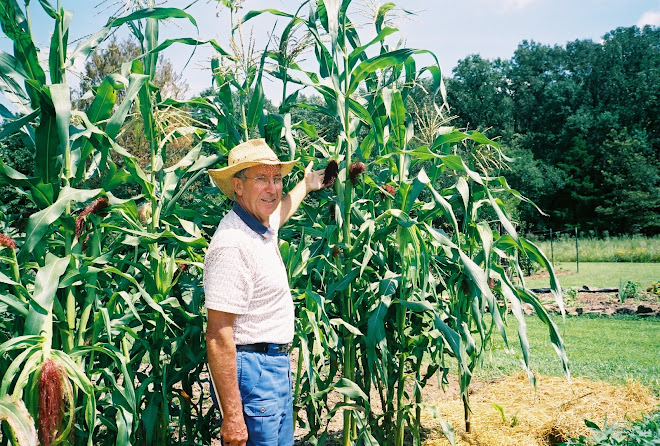
Living in Harmony with Nature and teaching others to garden the natural (organic) way, with emphasis on practices that lead to NUTRIENT DENSE produce!
Harmony Gardens
Bey Home designed by Stitt Energy Systems, Inc. 2002
Labels
Welcome To Our Site
About Me

- Harmony Gardens
- Fayetteville, Arkansas, United States
- Harmony Gardens is the home of Calvin and Doris Bey. As the name implies our goal is to live in harmony with the Laws of Nature. We are concerned about the environment, energy efficiency, organic gardening, alternative health, and sustainability issues. We love our Stitt Energy Systems Inc. energy efficient home, which received a First Place NAHB National Award for 2003. Calvin is a retired USDA Forest Service scientist. Each year he teaches classes in Organic Gardening in February and March and again in September. Doris is a retired RN. Calvin and Doris have put their energy efficient house up for sale (by owner). See first post for description, pictures, and house design.
January 11, 2011
Earthing for Better Health

January 3, 2011
The Roundup Story
The Roundup Story
Calvin F. Bey CFBey1936@cox.net
Few things in life are simple and gardening is no exception. Answers to questions on garden design, plant selection, soils, fertilizers, mulches, compost, cover crops, and rotations can become complex. To help simplify, I promote practices based on ecological rules. None of us would knowingly consume arsenic, simply because we know that poisons are bad for our health. A similar guiding ecological rule exists for gardening. “If a substance is toxic, i.e. not healthy for the soil, do NOT use it on the garden.”
What about the use of Roundup? Chemically known as glyphosate, Roundup kills almost anything that is green. Lawn, horticulture, and agriculture folks debate whether Roundup is safe.
At the recent AcresUSA meeting, Dr. Don Huber, spoke on the topic, “Understanding Glyphosate.” Huber is a retired Purdue University pathologist, who has researched the effects of Roundup for 20 years. His findings, and that of many others confirm the fact that Roundup is toxic and not good for the health of the soil or the plants.
Roundup was patented in 1974. The same product was patented 10 years earlier as a simple chelator, i.e. a substance that immobilizes or grabs and holds other compounds. So Roundup gets into the soil and grabs the elements, especially manganese and other micro nutrients.
Monsanto, the manufacturer, claimed Roundup was biodegradable. Oops. You don’t see that on the label anymore. In a French Court, it was proven that it did not fully degrade in the soil. Studies show that the negative effects of Roundup last for more than 10 years.
Worse than that, research studies from many places are showing reduction in vigor and yield, increased chlorosis, mottling, leaf distortions, bud and fruit abortion, plant infertility, increased attack by insects, and more. Other key consequences of using Roundup are:
1. It robs plants of nutrients, i.e. reduced uptake of manganese and other nutrients. This effect carries over to animals that consume the plants.
2. It reduces nitrogen fixation.
3. It increases the virulence of some pathogens and makes crops more susceptible to disease.
4. It kills beneficial soil organisms, and poisons the soil for all plants.
5. It increases lodging in crops.
6. It produces unfilled kernels in corn.
7. Weeds are becoming resistant and super-weeds are developing.
Huber showed examples in commercial production where glyphosate damage was severe, including crops where Roundup had not been applied for several years. In MN, 1000 acres of seed potatoes could not be certified because of excess glyphosate in the tubers, that came from growing Roundup Ready soybeans and spraying with Roundup the previous year. Lawsuits against Monsanto are in process in MN and ID regarding potatoes.
History teaches us that where societies have not taken care of the soil, the civilization fails. I don’t see the use of Roundup as a debatable issue. It is bad for the soil, our environment, our plants, our domestic and wild animals, human health, and our future. It’s a serious threat to the sustainability of agriculture and food production.
So what is the solution? We know Roundup should not be used! We know it is a serious matter. We know too that the answer begins with what we do in our own back yards. We owe it to our children and grandchildren to do what is right.
Have questions? Check out “Roundup” on the net and see for yourself. Read the 2010 Institute of Science in Society report, “Glyphosate Tolerant Crops Bring Diseases and Death.” It is replete with up-to-date references.
Garden 2007

Heirloom "Country Gentleman" Corn